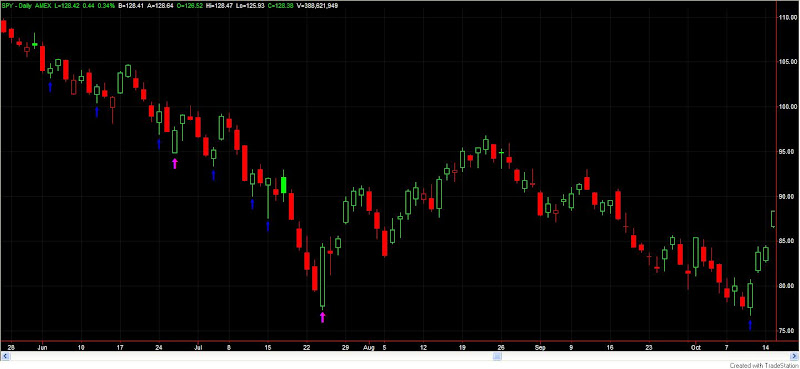Last week I discussed why and how I sometimes use options for short-term trades. Today I will expand on that with some rules I follow and other thoughts. If you didn’t catch last week’s post, you may want to check that out first.
As a very quick review, when trading in stocks or ETF’s that I anticipate being in for a number of days, rather than weeks or months, I frequently trade deep in the money options rather than the stock or ETF. The reasons and a general methodology were outlined last week. Below are some more specifics for you to consider along with answers to a few questions I received:
How do I decide whether an option is preferable to the stock?
Some general rules as to when I use options:
1) The stock should trade for at least $25 or more. The higher the better. I especially like stocks in the $40-$80 range. – The spread on many deep options is $0.10. Sometimes you’ll find something appropriate with a $0.05 spread, but not always. In many cases you can assume you will lose at least most of the spread on the trade. If I’m looking for a 2-3% move I don’t want to give away $0.10-$0.15 on a $15 stock. Doing that may destroy my edge. With low priced stocks I normally just buy the stock.
2) The option should have almost no premium – Even with higher priced stocks, I don’t want to pay much premium on the option. More than $0.15 or $0.20 and I begin to lose some interest. In low-volatility environments this is easily accomplished. During panic situations when the VIX spikes you’ll be hard pressed to find anything trading without a decent amount of premium.
3) I want enough time for the trade to work, but not too much time left on the option – The contracts are generally monthly. My trades average about 1 week. Two weeks to expiration is the sweet spot. Less than one week and I’m normally looking out to the next month (which means additional premium). Three weeks or longer and your going to have to pay for some time value. If the trade works quickly then you may be able to sell the option with time value left in it. There will be some erosion, though.
4) The delta should be 90 or higher – This is normally the case if you’re not paying much premium for a deep option. Basically, I want the price to move up very close to the same amount as the stock price.
What if the exit trigger doesn’t arrive before the option expires?
In this case some decisions need to be made. If I’m trading a stock then I’m normally not trading a size larger than I would trade if I owned the stock anyway. Therefore, taking delivery of the stock is an option. If it is index shares that I’m leveraged with, then I need to roll them out to the next month.
Rolling out to the next month adds some cost. First, you have basic transaction costs since you are selling your options and buying others. Frequently more significant is the premium cost. You are selling an option with 0 premium and buying one with some premium. To help reduce the amount of premium the roll will cost you, a spread trade normally helps. Rather than entering a sell for X contracts and then a buy for X contracts, put it in as a spread trade. Even though the option may trade with a $0.10 spread, you can enter spread trades to the penny.
When else might it be appropriate to switch option contracts?
If the trade goes sharply against you and you still feel positive about the position you could consider moving to a lower strike price (assuming long call). Two things will happen when your stock price rapidly approaches your strike price. 1) Premium may get built into the option since you are now near or at the money rather than deep into it. 2) The increase in premium will also mean a decrease in delta. So when the stock does bounce your option initially may go up $0.75 for every dollar rather than the $0.95 for every dollar that it would have when you bought it.
Therefore, one strategy to consider would be to sell the now “near the money” option you hold and buy a deep one. This accomplishes two things: 1) You are able to make money on the premium that was just built up and 2) You own an option with a higher delta that will rise faster than your original option.
Of course there is a big disadvantage to doing this, and that is that you are now laying out more capital. Part of the reason for using options is to control risk. Swapping out for deeper ones when the trade goes against you increases your initial risk, so it’s something that needs to be carefully thought through before doing it.
For index trades, why use options instead of futures?
There are advantages and disadvantages to both. Some advantages for options include: 1) They can be traded in the same account as stocks. No need to segregate to a futures account. 2) In low volatility environments, you can actually get more leveraged than with futures.
A big disadvantage rears its head in high volatility environments. When the market sells off hard and volatility spikes, even fairly deep index options carry a decent amount of premium. With futures this is not as much of an issue.
To sum up below are a list of advantages and disadvantages to using deep options for short-term trading vehicles:
Advantages:
Lower capital outlay
Lower risk (option goes to $0 before stock does)
Leverage without paying margin costs
Can be traded in same account as equities rather than separate futures account
Disadvantages:
Lower reward due to delta Higher slippage due to option spreads
Some premium costs
Premiums increase in volatile environments



